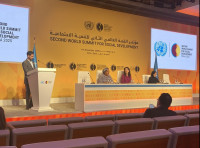Opinion
Beyond the growth figures
The government has projected that the economy would grow by almost 6.5 percent in fiscal year 2016-17.
Bhojraj Poudel
The government has projected that the economy would grow by almost 6.5 percent in fiscal year 2016-17. There were similar higher growth projections from different development agencies. For example, the Asian Development Bank (ADB) has predicted that the growth rate would be somewhere between 5.2 to 6.2 percent in fiscal year 2016-17. The International Monetary Fund (IMF) has stated that the economy would grow by 5.5 percent in its 2017 report. These figures are encouraging for a country that has seen an average growth rate of only 4 percent in the last two decades.
But the projected higher growth rate is not led by infrastructure development. So the higher growth rate won’t be reflected significantly in people’s lives through job creation and income generation. Since the growth rate is mostly due to timely monsoon and ballooning import of consumer goods, there is a looming fear that it may not be durable.
The government has identified a total of 21 national priority projects that have direct links with urban, semi-urban and rural populations. Right now, the most important aspect of development is building infrastructure that complements urban life and facilitates rural-urban migration. But the Development Committee under the Legislature-Parliament has concluded that none of the national pride projects would be completed in time. Only four out of the 21 pride projects have completed more than 50 percent of the work. Underlining the importance of fast-paced development of national pride projects, the Development Committee has directed the government to expedite work on these 21 projects.
Urbanisation and migration
Nepal’s average urban population density is 1,381 per square kilometre, whereas the total population density is 180 per square kilometre, according to the 2011 census by the Central Bureau of Statistics (CBS). Increasing urbanisation demands quick construction of infrastructure so that migration and urbanisation are in sync. Kathmandu, Pokhara, other medium-sized cities and some small towns along different highways are expanding, but severely lack adequate urban facilities such as education, health, drinking water, sanitation, public transport, electricity supply and, most importantly, land zoning.
Remittance has been the mainstay of Nepal’s economy for many years. The official estimation is that the ratio of remittance to GDP is 32.1 percent in fiscal year 2015-16. Income from remittance has registered a 4 percent growth in fiscal year 2015-16, which is reflected in the form of semi-urbanisation in different parts of the country. If the government works to accelerate the pace of infrastructure projects, emerging semi-urban clusters could add value to the overall economic development more efficiently.
Infrastructure development connects rural population to the nation’s economic development, facilitating better access to health, education and advanced means of doing agricultural activities. In such a scenario, youths would find job opportunities in Nepal rather than having to migrate abroad. Evidently, development of high-end infrastructure projects would create job opportunities for all kinds of labourers—skilled, semi-skilled and unskilled. In such a fast-paced development process, Nepal could utilise its own working population to build a prosperous nation.
Infrastructure-led capital spending
Capital expenditure in Nepal has consistently been low, creating strong barriers to economic development. With less than three months remaining in the fiscal year, the government’s capital spending stands at less than 30 percent of the total capital budget allocation of Rs312 billion for the current fiscal year. The government has to expedite the development of infrastructure projects so that money travels through all the veins of state apparatus and also through the private sector. This would employ a large number of working-age population and boost capital spending. However, there is no magic wand to increase capital spending through infrastructure development. The government has to design, process and implement various infrastructure projects connecting different parts of the country through road, rail and air.
In addition, health and education infrastructures in Nepal are way below standards. For example, a visit to the library of Tribhuvan University in Kirtipur shows how unmanaged and ugly it is. Students studying there do not even get basic amenities such as proper toilets and drinking-water taps. This applies to any public education institution in Nepal. Needless to say, availability of basic amenities can be instrumental in enhancing the quality of education. The government has to spend on improving the quality of health and education infrastructures.
The economic growth rate figures should be directly reflected in citizen’s lives. This happens only if the government actually develops what is required and not just counts the numbers to project an inflated sense of development for public consumption. The projected economic growth rate for the current fiscal year comes mainly from the availability of farm inputs such as seeds and chemical fertilisers, timely monsoon, imports and somewhat increased levels of post-earthquake reconstruction activities. But these are not a result of planned development and expenditure to generate jobs and wealth. There has been no substantial progress in addressing the pressing needs of the economy that could uplift people’s livelihood and lay the foundation to sustain the growth rate in the coming years.
Trickier future path
McKinsey & Company, a management consulting firm, concludes in its Infrastructure Financing Report that inadequate infrastructure—and the resulting congestion, power outages and lack of access to safe water and roads—is a global concern. Worryingly, the pace of urbanisation in Nepal is the lowest in South Asia. As Nepal is entering a new kind of administrative structuring, large-scale infrastructure development might be mired in provincial disputes in the future. The government has to ensure that the national priority projects do not fall victim to bureaucratic inefficiency, provincial disputes and political bickering. As McKinsey & Company highlights, Nepal will face haphazard urbanisation in the near future if the government does not address the issue right now. For instance, the more time the government takes, the more difficult it will be to acquire land for project development.
Rabindra Adhikari, chairman of the Development Committee under the Legislature-Parliament, has been vocal about reminding the government time and again to complete at least the 21 priority projects on time so that the country’s growth figures will reflect improvements in people’s lives. The more the government delays developing these infrastructures, the harder it will be in the future.
Poudel works as a consultant economist for the Asian Development Bank, Nepal Resident Mission; views expressed here are personal




 23.12°C Kathmandu
23.12°C Kathmandu










